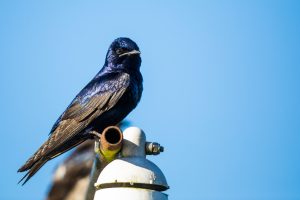Purple Martin Colony Shows Steady Growth in 2022

Purple Martin Rests Above Nest Box
The numbers are in and the housing market is hot for the Port of Vancouver USA’s purple martin colony! For the past 11 years, the port has partnered with Ridgefield National Wildlife Refuge bird experts to increase populations in Southwest Washington. This is done by placing nesting gourds at appropriate sites and monitoring the birds’ nesting activity year over year.
Purple martins are rare migratory birds that winter in South America and move north into the U.S. and Canada in the summer. The primary purple martin nesting and foraging habitat in Washington is open land near water. They occupy gourds at least 10-feet high and can be found in developed areas, along waterfronts, and in fields, wetlands, and clearings – making the port’s wetland mitigation bank an ideal location.
The birds feed on insects they catch in the air including flies, dragonflies, damselflies, butterflies, wasps, bees, and mayflies. They also feed on beetles, spiders, and grasshoppers. Purple martins fly higher than other swallows, often flying over 150 feet off the ground.
The purple martin nesting program started in 2011 with 16 nesting gourds at the Columbia River Wetland Mitigation Bank and increased that amount to 32 in 2019. This fall, volunteers were able to confirm 43 successful hatches, an increase of 7 hatches from the 2021 nesting season.
“We are excited to see the population of purple martins increasing every year,” said port Environmental Manager Matt Graves. “It’s a great sign for the years to come.”
Volunteers with the wildlife refuge, under permit with the U.S. Fish and Wildlife Service, band the chicks within 12 to 21 days of hatching and document their age using a photographic scale. These fascinating birds develop day by day, to the point where their age can be identified from visual indicators such as feathering on the head or back, and wing feather emergence. Banding the birds helps experts with tracking the birds’ location.
While this year’s nesting season is over for the purple martins, the team is looking forward to seeing even more successful nesting in 2023.
Wildlife success and diversity in natural areas around the port is just one of the many ways the port manages its environmental efforts. Learn more about the port’s environmental programs in its Sustainability Report and Climate Action Plan.
